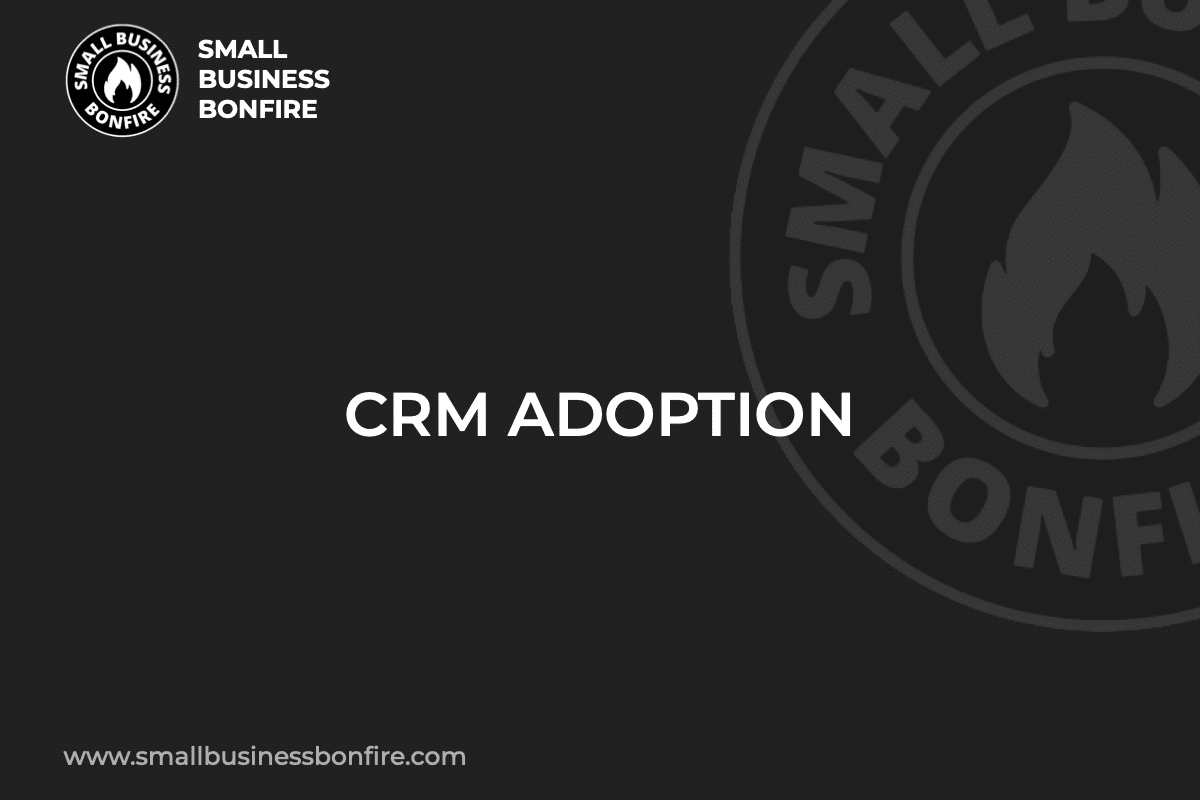Have you recently implemented CRM software to improve your business processes but found some of your team members not utilizing the new tools?
Even the best CRM solution is only worthwhile if your team is on board and using the technology.
My name is AJ. I’ve built and sold a successful company for multiple seven figures. One thing that drove such success was team buy-in after implementing CRM tools.
After years of learning tricks to CRM user adoption, I’ve compiled this guide to help other small business owners encourage their teams and make the most of a new CRM!
Let’s dive in!
Key Takeaways
- Most of the CRM projects that fail are due to low adoption rates and team buy-in.
- Gamifying CRM training is an effective way to motivate employees to learn the software.
- A strong CRM adoption rate leads to more productivity, increased team collaboration, and better data quality.
- Utilize CRM user metrics to analyze how your team members use the technology and indicate ways to improve.
Related Reading: Best Small Business CRM
SBB Featured Partners
What is CRM Adoption?
CRM adoption is the percentage of users that actually use a CRM system compared to the total number of seats purchased.
One of the most significant challenges was encouraging my employees to use a CRM tool.
Why?
Most businesses endure low CRM adoption rates for the following reasons:
- The software is unnecessarily complex
- Poor user experience
- Lack of initial training
- Disorganized CRM onboarding process
It is your job as a leader to improve CRM user adoption. And while this may seem challenging, there are several effective techniques.
The Risk of Poor CRM Adoption
The most considerable risk of low adoption rates is a significant loss in revenue.
CRM systems are an investment up front, requiring much time and money to implement. Therefore, when employees don’t buy into a new CRM, the investment money goes to waste.
On the other hand, high adoption rates are associated with the following metrics:
- Higher productivity
- Quicker, data-driven decision making
- Shorter sales cycles
- More accurate customer data
- Streamline sales and marketing efforts
A comprehensive CRM adoption strategy is vital if you want to see a return on your investment!
CRM Adoption Metrics to Track
Are there ways to track whether CRM adoption rates improve or decline?
Yes! Here are three metrics I’ve used to track how well my team accepts a new CRM system.
Usage Metrics
Usage metrics are the simplest and most direct way to measure your user adoption rate.
Analyze your CRM login rate, indicating which employees access your CRM.
Additionally, you can track behavior metrics to see how in-depth your team uses the CRM platform. For instance, you can include these data points:
- Task completion
- Emails sent
- Deal status updates
- Contact or opportunity record creation
Data Quality Metrics
Your team must input accurate customer data to ensure you use your CRM software effectively.
Check your most essential data points monthly and evaluate how many contacts have all of their key fields completed.
Although manual data entry is repetitive and mundane, it’s essential to implementing a new CRM.
Poor data quality leads to a less useful CRM.
Performance Metrics
Another way to measure the success of CRM implementation is by tracking performance metrics.
Performance metrics, such as sales cycle length or customer churn rate, help you determine whether your team uses the CRM system to improve their operations.
These metrics provide a more comprehensive view of what’s working and what isn’t with your CRM software.
Benefits of Increased CRM Adoption
High CRM adoption rates include several long-term benefits for you and your team.
Below I’ve listed the advantages I noticed after focusing on improving CRM implementation within my company.
Increased Sales Team Efficiency
An efficient CRM system combines automation and data organization, ensuring sales reps don’t spend time with repetitive tasks.
In turn, your sales team can focus on building stronger customer relationships.
When you improve CRM adoption rates, the software ensures employees are more productive and efficient with their daily tasks.
Remaining Competitive in Your Market
Improving user adoption also means your team utilizes the best customer relationship management technology.
As a result, your business stays competitive in your market and can even gain a slight advantage over some of your competition.
Reduce Support Questions
When CRM users understand how to use the software, they don’t have to rely on IT teams to answer CRM-support-related questions.
Instead, your team is self-reliant and understands the ins and outs of your CRM platform.
Improve Customer Satisfaction
Strong CRM implementations allow you and your team to understand your customers better because in-depth data track their needs, preferences, etc.
Therefore, your team can use this CRM data to provide personalized support that leads to higher levels of customer satisfaction!
Better Data Management
When you drive CRM adoption, your company gains access to in-depth customer data that your team can use for:
- Identifying trends
- Making informed decisions
- Driving more sales
- Building stronger relationships
As your marketing and sales teams analyze this data, your company gains valuable insights into your customer’s preferences.
Increased Team Collaboration
Lastly, strong adoption rates lead to better collaboration and communication throughout your company.
Your teams can work together more efficiently because everyone can access the same customer data.
How to Increase CRM Adoption
Now that you understand the benefits of a high CRM adoption rate, it’s time to learn how to get your employees excited about the new software.
Strong CRM adoption rates may seem difficult. However, with the proper steps, you can reduce the time it takes to encourage team members to use the new software.
Here are nine steps I took with my previous company to boost our CRM adoption rate.
Get an Easy to Use CRM
Investing in an easy-to-use CRM improves buy-in rates significantly because employees are less frustrated by learning new technology.
Numerous easy-to-use CRMs in the CRM industry are designed for small businesses and small teams.
One way to test whether or not a CRM is intuitive is by utilizing the free trial (if it’s available).
Educate Your Team On CRM Advantages
Inform your team why CRM usage is beneficial to everyone.
Some of the benefits you can address include the following:
- Improved customer satisfaction
- Automated tasks
- In-depth data about customers and the sales pipeline
- Greater efficiency and productivity
- Higher sales and revenue
Numerous CRM research studies prove why companies should implement this technology.
Appoint a CRM Manager
Delegating authority to a CRM manager is an effective way to get full buy-in from the entire team.
This manager should be someone who can understand how your company will use the CRM system and explain its advantages to everyone.
Appointing a CRM manager ensures you implement the software correctly, and a professional answers employees’ questions.
Write an SOP for Your CRM
How do you want your CRM to streamline business processes? What tasks do your employees need to take?
Take time to write standard operating procedures for your CRM to ensure each team member understands what they should do.
Additionally, writing SOPs keeps everything organized, helping more employees buy in because they see you take implementation seriously.
Gamify CRM Adoption with Your Sales Team
An excellent (and fun) way to boost your CRM adoption rate is by turning learning into a game.
Utilize a digital adoption platform to train employees about the new CRM systems.
Digital adoption platforms provide training in an app through guided walkthroughs, videos, and tutorials. Therefore, CRM users learn by doing.
And when you assign point values to training tasks, sales reps are more likely to engage and be excited about learning.
Offering small rewards effectively encourages your team to learn about your customer relationship management software.
Automate Key (Lame) Sales Processes
Meet with your sales managers and determine any points in the sales process that could be automated.
Automation frees up time for your sales reps, allowing them more time to build customer relationships.
Not every task can be automated, but tasks like data entry, sending messages, and setting reminders can be.
Involve Your Team from the Start
It’s integral to involve anyone using the CRM software from the start.
I even included sales leaders and customer service staff during the selection phase when I was determining the best program for our needs.
During this stage, ask for feedback and determine what’s working and the areas with the most resistance.
As leaders understand the areas of improvement, they can offer solutions and ideas to ensure strong CRM adoption rates.
Remember, your employees use the software daily, so it only makes sense to involve them from the start.
Monitor and Record Adoption Rates
Monitoring your adoption rates and analyzing how your team uses the new technology is also integral.
For instance, several CRMs allow you to analyze the following:
- Features that are not being used properly
- Who is logging into their CRM account
- Features that your team isn’t using at all
- How many users are currently in training courses
- Whether or not users are engaging with the software
Additionally, have frequent meetings with your team and ask what areas they’re struggling with and which aspects they need support with.
Alert Your Team on CRM Workflow Changes
Lastly, you must inform any CRM users when you make workflow changes.
As your business changes, your CRM system will too. And as these changes occur, you must inform team members so they can do their jobs effectively.
Think about it. Would you want to be in the dark if one of your daily tasks suddenly changed?
Ensuring everyone is on the same page is critical to maintaining efficiency and high adoption rates.
CRM Adoption Challenges (And How to Overcome Them)
CRM adoption challenges are frustrating (trust me, I know). It may seem impossible to get through to some employees.
Here are six common CRM adoption challenges and strategies for overcoming them!
CRM Adoption Challenge: Resistance to Change
Some team members may resist change because they’ve gotten used to how things are done.
People in this category often fear they won’t understand the CRM features, that the software will disrupt their work, or that the technology isn’t worth the time and effort to learn.
Offer personalized CRM guidance for these team members and show them the statistics proving CRM platforms improve their work, not disrupt it.
CRM Adoption Challenge: Integrations with Existing Systems
Some third-party integrations can be complex because they aren’t compatible with your CRM system.
When these two technologies are integrated, employees can easily become frustrated when switching between systems.
Look for CRM platforms compatible with existing software before investing in new software to combat this issue.
Or, check if CRM features enable you to do the same thing as your current third-party system.
CRM Adoption Challenge: Data Quality Issues
Employees are less likely to trust a new CRM with poor data quality.
Further, when employees don’t trust the information in the CRM, they are more hesitant to use it.
Your CRM implementation project must have a designated time to transfer data. Additionally, you must check your data quality regularly to ensure your team has the most accurate information.
Insightful customer data is one of the primary details that lead to business and CRM growth.
CRM Adoption Challenge: Implementation Costs
CRM solutions can get expensive. Before you know it, you’re spending money on the following things to implement your CRM system:
- New software
- Hiring consultants or developers to customize your CRM
- Training employees
- Transferring data
Sometimes, these costs create barriers to adoption, especially for small businesses.
Look for a low-cost CRM with a free trial period to ensure you don’t spend too much on new software.
Also, construct a CRM implementation plan, ensuring you stay on schedule and under budget while implementing a new CRM.
CRM Adoption Challenge: Security Concerns
Some employees resist new software because they hesitate to store sensitive customer data in the CRM.
When employees feel there aren’t strong security measures, they grow concerned about data breaches and unauthorized access.
Invest in extra security if needed (although most companies in the CRM industry ensure data protection).
Also, it may ease some team members’ minds if an outside IT specialist ensures your company’s data is secure.
CRM Adoption Challenge: Team Buy In
Most CRM implementations fail because of a lack of team buy-in.
If employees can’t see the real business value CRMs add, it can negatively impact business performance.
Before implementing a CRM, have meetings explaining the new technology’s advantages and getting your team excited about the new opportunities ahead.
I found incredible success when I hired an outside CRM specialist to train team members and explain how and why the new technology is worth learning.
Conclusion
CRM adoption is the first step when implementing an effective CRM solution.
Higher adoption rates lead to increased team productivity, better company collaboration, and fewer customer support inquiries.
What strategies did you use to motivate employees to adopt a CRM? Let us know in the comments section.
Good luck motivating your employees to utilize your new CRM!
Newsletter Signup
Join The Leads Field Guide Newsletter for tips, strategies and (free) resources for growing your leads, and closing more deals.




